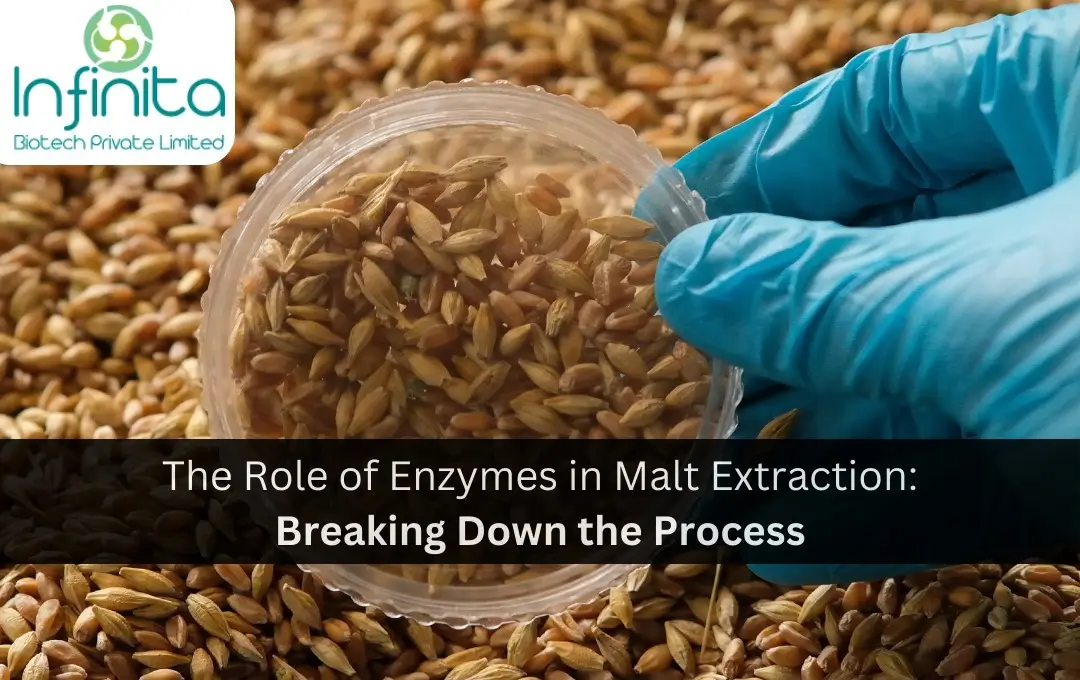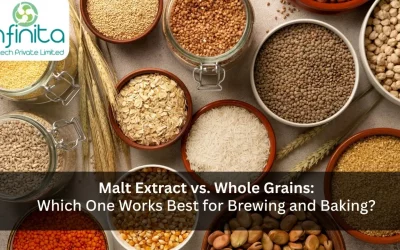Malt extraction is a crucial step in the brewing process. It involves breaking down the complex carbohydrates in malted grains to release fermentable sugars. This process is made possible with the help of enzymes, which are biological catalysts that speed up chemical reactions. Understanding the role of enzymes in malt extraction is key to producing high-quality brews. In this article, we will explore the nature of enzymes, the science behind malt extraction, the interplay between enzymes and malt, the effect of temperature and pH on enzyme activity, and innovations in enzyme use for malt extraction.
Understanding Enzymes: A Brief Overview
Enzymes are protein molecules that play a vital role in biological processes. They act as catalysts, accelerating chemical reactions without being consumed in the process. Enzymes are highly specific, meaning each enzyme is designed to catalyze a particular reaction. In the case of malt extraction, specific enzymes are responsible for breaking down complex carbohydrates into simpler sugars that can be fermented by yeast.
Enzymes are truly remarkable biological molecules that have fascinated scientists for centuries. Their ability to speed up reactions that would otherwise occur at a much slower rate is essential for life as we know it. The study of enzymes, known as enzymology, is a complex and dynamic field that continues to uncover new insights into these molecular machines.
The Nature of Enzymes
Enzymes are three-dimensional structures with a specific active site where substrates bind. This binding induces a conformational change in the enzyme, leading to the catalytic reaction. Enzymes are sensitive to environmental factors such as temperature and ph. Optimal conditions for enzyme activity vary depending on the enzyme involved.
The active site of an enzyme is like a lock that can only be opened by the correct key, or substrate, in this case. This specificity ensures that enzymes only catalyze their target reactions, preventing unwanted side reactions. The intricate dance between enzymes and substrates is a beautiful example of the precision and elegance of biological systems.
The Different Types of Enzymes
There are several types of enzymes involved in malt extraction. Amylases are responsible for breaking down starches into maltose, a fermentable sugar. Proteases break down proteins into amino acids, which provide nutrients for yeast during fermentation. Beta-glucanases help break down viscous β-glucans, improving wort filtration.
Each type of enzyme in malt extraction serves a specific purpose in the overall process of converting grains into delicious beer. The coordinated action of these enzymes is essential for extracting the sugars and nutrients needed for yeast to carry out fermentation. Understanding the roles of these enzymes not only enhances the brewing process but also provides valuable insights into the biochemistry of malt metabolism.
The Science Behind Malt Extraction
Malt plays a crucial role in brewing, providing fermentable sugars and flavor compounds. To extract these valuable components, malt needs to undergo a mashing process. During mashing, malt is mixed with hot water to activate enzymes. These enzymes then break down the carbohydrates and proteins present in the malt, creating a mash that contains fermentable sugars.
One key enzyme involved in the mashing process is amylase. There are two types of amylase enzymes present in malt – alpha-amylase and beta-amylase. Alpha-amylase breaks down starches into long chains of sugars, while beta-amylase further breaks these chains into shorter, fermentable sugars like maltose. The temperature and pH levels during mashing are carefully controlled to optimize the activity of these enzymes.
The Importance of Malt in Brewing
Malt provides fermentable sugars, which are converted into alcohol and carbon dioxide by yeast during fermentation. It also contributes to the flavor, color, and body of the final beer. Different malt varieties, such as pale malt or roasted malt, impart distinct characteristics to the brew.
Aside from sugars, malt also contains proteins that play a role in yeast nutrition and beer foam stability. The proteins in malt undergo modifications during mashing and boiling, affecting the mouthfeel and head retention of the beer. Additionally, malt husks act as a natural filter bed during lautering, helping to clarify the wort by trapping solid particles.
The Process of Malt Extraction
The process of malt extraction involves several steps. First, malt is crushed to expose the enzymes contained within. The crushed malt is then mixed with hot water to form a mash. Enzymes in the mash convert starches into fermentable sugars. After mashing, the liquid portion of the mash, known as wort, is separated from the solid residue. The wort is then boiled, hops are added for bitterness and aroma, and yeast is introduced for fermentation.
After boiling, the wort is rapidly cooled to a temperature suitable for yeast pitching. This cooling process helps to precipitate proteins and tannins, which can cause haze in the final beer if not removed. Once the wort is cooled, yeast is added to begin fermentation. The yeast consumes the sugars in the wort, producing alcohol and carbon dioxide as byproducts. This fermentation process typically takes place over several days to weeks, depending on the desired beer style.
The Interplay Between Enzymes and Malt
The success of malt extraction relies on the interplay between enzymes and malt. Enzymes present in malt are activated during mashing and work synergistically to break down carbohydrates and proteins. The composition of the malt and the specific enzymes present can greatly influence the final characteristics of the beer.
Enzymes are fascinating biological catalysts that speed up chemical reactions without being consumed in the process. In the context of malt extraction, enzymes act as molecular scissors, cutting through complex molecules to release simpler building blocks. This breakdown is essential for the production of fermentable sugars that are vital for yeast metabolism during fermentation.
How Enzymes Aid in Malt Extraction
Enzymes, particularly amylases, play a crucial role in malt extraction by breaking down starches into fermentable sugars. This process is known as scarification. Through their catalytic action, enzymes convert complex carbohydrates into simpler sugars that can be consumed by yeast during fermentation. Without enzymes, the conversion of starches into sugars would be slow and inefficient.
Aside from amylases, proteases are another group of enzymes present in malt that target proteins. These enzymes help break down proteins into amino acids, which contribute to the flavor profile and mouthfeel of the final beer. The coordinated action of different enzymes is like a symphony, each playing its part to create a harmonious end product.
The Impact of Enzymes on Malt Quality
The quality of enzymes present in malt greatly affects the end result of malt extraction. Enzymes that are well-preserved and active lead to efficient carbohydrate and protein breakdown, resulting in higher sugar yields and improved beer flavor. However, enzymatic activity can be influenced by factors such as temperature, pH, and aging, which can impact the overall quality of the malt and the final beer.
Enzymes are sensitive entities that require optimal conditions to function at their best. For example, amylases have specific temperature ranges at which they are most active, and deviations from these ranges can lead to reduced efficiency in sugar production. Brewers carefully monitor and adjust mashing parameters to create an environment that maximizes enzymatic activity and ensures consistent malt quality.
The Effect of Temperature and pH on Enzyme Activity in Malt Extraction
Temperature and pH have a significant impact on enzyme activity during malt extraction. Enzymes have specific temperature ranges and pH optima at which they exhibit the highest activity. Understanding these factors is crucial for optimizing the enzymatic breakdown of carbohydrates and proteins in malt.
The Role of Temperature in Enzyme Function
Temperature affects enzyme activity by influencing the rate of molecular motion. Enzymes have an optimal temperature range at which they function most effectively. Deviating from this range can lead to decreased enzyme activity or denaturation. For malt extraction, the temperature during mashing is carefully controlled to ensure optimum enzyme activity and maximum sugar extraction.
The Influence of pH on Enzyme Activity
pH plays a vital role in enzyme function as it affects the ionization state of amino acid residues present in the enzyme’s active site. Each enzyme has an optimal pH range at which it exhibits the highest activity. pH values outside this range can alter enzyme conformation and reduce catalytic efficiency. Maintaining the appropriate pH during mashing is crucial for promoting enzyme activity in malt extraction.
Innovations in Enzyme Use for Malt Extraction
The brewing industry consistently seeks innovative solutions to improve malt extraction processes. Advances in enzyme technology have provided brewers with more efficient tools to achieve desired beer characteristics.
Advances in Enzyme Technology
New enzyme formulations have been developed to enhance key aspects of malt extraction. These enzymes are tailored to specific brewing needs, such as improving wort filtration, increasing sugar yields, or enhancing flavor development. By using these advanced enzymes, brewers can optimize their processes and create unique beer profiles.
Future Prospects for Enzyme Use in Malt Extraction
The future of enzyme use in malt extraction looks promising. Researchers are continually discovering new enzymes and unlocking their potential in brewing applications. By harnessing the power of enzymes, brewers can improve efficiency, reduce costs, and create a wide range of beer styles with distinct characteristics.
In conclusion, enzymes play a vital role in malt extraction by breaking down complex carbohydrates and proteins to release fermentable sugars. Understanding the interplay between enzymes and malt, as well as the factors that influence enzyme activity, is essential for producing high-quality brews. Innovations in enzyme technology offer brewers exciting new possibilities for optimizing malt extraction processes. As the brewing industry continues to explore the potential of enzymes, we can anticipate further advancements that will shape the future of malt extraction and the beer we enjoy.







